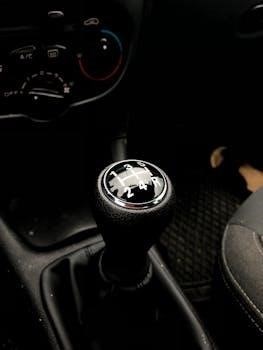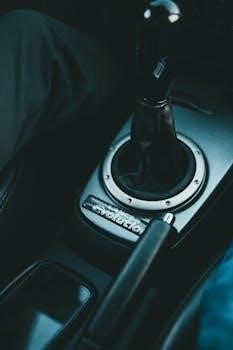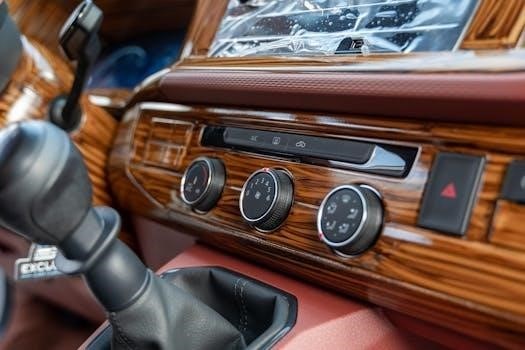Sequential Gearbox Manual⁚ An Overview
For driving enthusiasts, mastering gear changes is a unique thrill. The gearbox is key to turning engine power into motion efficiently.
Sequential gearboxes offer precision in delivering power to the wheels. They are mostly found in motorcycles and racing cars nowadays.
Unlike standard gearboxes, sequential ones allow shifting up or down in a specific order. This is often done through a paddle shifter.
Definition of Sequential Gearbox
A sequential gearbox, also known as a sequential manual transmission or sequential transmission, represents a specialized type of transmission system predominantly employed in high-performance vehicles and motorcycles. This innovative design distinguishes itself from conventional manual gearboxes through its unique gear selection mechanism. In contrast to the H-pattern shift lever arrangement found in traditional manuals, a sequential gearbox mandates that the driver shift gears in a specific, sequential order, either up or down the gear range. This sequential operation eliminates the possibility of skipping gears, ensuring a streamlined and efficient shifting process. The core function of a sequential gearbox involves rotating a ratcheting drum, which in turn manipulates gear selector forks to engage different gears. This design promotes faster shift times, consistent hand location, and prevents mis-shifting, making it ideal for racing and high-performance applications. These gearboxes, typically non-synchronous, often integrate dog boxes for synchronization, further enhancing their performance capabilities compared to torque-operated synchronizers.

How Sequential Gearboxes Work
Sequential manual transmissions operate similarly to standard manuals. Shifting changes the interaction of gears.
Power flows from the engine to the wheels. These gearboxes have gears lined up on one input shaft for efficiency.
Mechanism and Operation
A sequential manual transmission still uses gear selector forks to move collars that engage gears, like a standard manual transmission. The core difference lies in how the control rods are manipulated. The traditional H-pattern is replaced with a forward/backward motion for shifting. In race cars, pushing the shift lever forward up-shifts, while pulling it backward downshifts. This consistent motion simplifies the shifting process. Some Formula One cars use paddles on the steering wheel⁚ left for up-shifting and right for downshifting. Motorcycles use a foot-operated lever for the same sequential action. These motions rotate a ratcheting drum, which has grooves cut into it. The grooves either control standard control rods or directly move the gear selector fork. This drum rotation moves the rods or forks according to the grooves, changing the gears. This design mandates sequential shifting, preventing skips between gears. You must always go through the intermediate gear. This eliminates shifting mistakes, ensuring the next gear is always engaged.
Role of the Ratcheting Drum
The ratcheting drum is a central component in the sequential gearbox mechanism. Its primary function is to translate the driver’s shift lever input into the precise engagement of specific gears. The drum features grooves meticulously cut into its surface, acting as guide rails for the gear selector forks or control rods. As the driver moves the shift lever, this action rotates the drum incrementally. Each rotation corresponds to a specific gear change, dictated by the groove patterns on the drum’s surface. These grooves dictate the movement of the selector forks, which in turn engage or disengage the appropriate gears on the transmission shafts. The drum’s design ensures that gears are selected in a strict sequence, one after the other, eliminating the possibility of skipping gears. This sequential operation is fundamental to the advantages offered by this gearbox. Because of the drum, you have to shift in sequence. There is no skipping from one gear to another.

Advantages of Sequential Gearboxes
Sequential gearboxes offer several benefits over traditional manual transmissions, especially in performance applications.
These advantages include faster shift times, and consistent hand locations for a better overall experience.
Faster Shift Times
One of the primary advantages of a sequential gearbox is its ability to facilitate faster shift times compared to traditional H-pattern manual transmissions. In a conventional manual gearbox, shifting between gears requires the driver to navigate a specific pattern, often involving diagonal movements and precise positioning of the shift lever. This process can be time-consuming and prone to errors, especially during high-pressure situations such as racing or performance driving.
In contrast, a sequential gearbox simplifies the shifting process by allowing the driver to shift up or down through the gears in a linear sequence. This is typically achieved through a simple push or pull motion of the shift lever, or through the use of paddle shifters located on the steering wheel. The elimination of the H-pattern and the direct, sequential nature of the shifts significantly reduce the time required to change gears.
Faster shift times translate directly into improved performance, particularly in racing applications. By minimizing the time spent shifting, drivers can maintain momentum and accelerate more quickly, leading to faster lap times and improved overall results. The ability to shift gears rapidly and efficiently can also provide a competitive edge in situations where quick acceleration or deceleration is crucial, such as overtaking maneuvers or corner exits.
Consistent Hand Location
Another significant advantage of sequential gearboxes, particularly in high-performance driving scenarios, is the consistent hand location they provide. With a traditional H-pattern manual transmission, the position of the shift lever changes depending on the gear the vehicle is in. This requires the driver to constantly adjust their hand position and memorize the specific location of each gear within the H-pattern. This can be distracting and time-consuming, especially during intense driving situations where focus and precision are paramount.
In contrast, a sequential gearbox maintains a consistent hand location for shifting. Whether the driver is upshifting or downshifting, the motion of the shift lever or paddles remains the same. This eliminates the need to search for the correct gear position, allowing the driver to maintain a more stable and consistent grip on the steering wheel. This consistent hand location contributes to improved driver control, reduced fatigue, and enhanced overall driving performance.
The benefit of consistent hand location is particularly noticeable in racing environments, where drivers need to make quick and precise gear changes while simultaneously managing steering, braking, and other vehicle controls; By simplifying the shifting process and eliminating the need to search for gears, sequential gearboxes allow drivers to focus their attention on the track and maintain optimal control of the vehicle.
Prevention of Mishing
One of the most crucial benefits of a sequential gearbox, especially in high-stress driving situations like racing, is its ability to prevent “mishing,” or accidental mis-shifts. In a traditional H-pattern manual transmission, it’s possible, particularly under pressure or when rushing a shift, to inadvertently select the wrong gear. For example, a driver intending to downshift from 4th to 3rd gear might accidentally select 5th or even 2nd. Such a mistake can have catastrophic consequences, potentially over-revving the engine and causing significant damage, or upsetting the car’s balance and leading to a loss of control.
Sequential gearboxes mitigate this risk entirely. Because the driver can only shift up or down to the next adjacent gear in the sequence, there is no possibility of accidentally selecting a gear that is several positions away from the intended one. This eliminates the potential for over-revving the engine due to a missed downshift or lugging the engine from an upshift into too high of a gear. The prevention of mishing provides a significant safety margin, allowing drivers to push the limits of their vehicle without fear of a costly or dangerous mistake.
This feature is invaluable in racing, where drivers are constantly pushing their vehicles to the edge of their performance envelope. The reduced risk of mechanical damage and improved driver confidence contribute significantly to faster lap times and a more competitive edge.
Wider Range of Gear Ratios
Sequential gearboxes offer a notable advantage in terms of the flexibility they provide in selecting and utilizing a broader spectrum of gear ratios. This stems from their design, where gears are arranged linearly rather than constrained by the physical limitations of a traditional H-pattern shift gate. In a conventional manual transmission, the shift gate’s shape dictates the possible gear positions and, consequently, the achievable gear ratios. This can impose restrictions on the granularity of gear selection and the overall range of ratios available.
With a sequential gearbox, however, designers have greater freedom to optimize gear ratios for specific performance requirements. The linear arrangement allows for closer spacing between gears, enabling finer adjustments to the engine’s torque output and speed. This is particularly beneficial in racing applications, where maintaining the engine within its optimal power band is critical for maximizing acceleration and overall performance. The ability to choose from a wider array of ratios enables drivers to fine-tune their vehicle’s response to varying track conditions and driving styles, ultimately enhancing their competitive edge. Moreover, this flexibility extends to accommodating different engine characteristics and vehicle weights, making sequential gearboxes a versatile choice for a diverse range of high-performance applications.
Applications of Sequential Gearboxes
Sequential gearboxes are commonly found in motorcycles due to their compact design and rapid, intuitive shifting capabilities.
They are also heavily used in race cars for faster shifts and consistent hand placement, improving overall lap times on circuits.
Motorcycles
Motorcycles commonly employ sequential gearboxes because they offer a much faster and more intuitive shifting experience compared to traditional manual transmissions. On a motorcycle, the rider shifts gears by clicking a lever up or down with their toe, enabling rapid gear changes without the need to search for the next gear in an H-pattern. This sequential shifting mechanism is ideally suited for the dynamic riding conditions encountered on motorcycles, whether navigating city streets or carving through winding roads. The sequential gearbox allows riders to maintain better control and focus on the road ahead, as the simple up-or-down motion reduces the cognitive load associated with gear changes. Furthermore, the compact design of sequential gearboxes makes them well-suited for the limited space available on motorcycles. The absence of complex linkages and shift patterns contributes to a lighter and more streamlined transmission system, which is essential for optimizing the performance and handling characteristics of a motorcycle. In addition, the sequential gearbox enhances the overall riding experience by providing quicker and more precise gear changes, resulting in smoother acceleration and improved responsiveness. The intuitive nature of the sequential shift lever allows riders to seamlessly transition between gears, maximizing power delivery and minimizing disruptions to the flow of riding. This ultimately leads to a more engaging and enjoyable riding experience, especially for performance-oriented motorcycles where quick and accurate gear changes are paramount. Moreover, the durability and reliability of sequential gearboxes make them a popular choice for motorcycles, as they can withstand the rigors of demanding riding conditions and frequent gear changes.
Race Cars
Race cars are a primary application for sequential gearboxes due to their significant advantages in speed, precision, and control, which are crucial for competitive racing. Unlike the H-pattern shift found in traditional manual transmissions, sequential gearboxes allow drivers to shift up or down through gears in a linear sequence, using a simple push or pull motion. This eliminates the need for complex hand movements and reduces the risk of mis-shifts, which can be catastrophic in a race. The sequential shift is quicker and more consistent, enabling drivers to maintain optimal engine performance and minimize lap times. In Formula One cars, paddle shifters located on the steering wheel further enhance the speed and efficiency of gear changes, allowing drivers to up-shift with the left paddle and downshift with the right, without ever removing their hands from the wheel. This seamless integration of gear control improves driver focus and responsiveness, contributing to faster and more precise driving. The consistent hand location and the elimination of surprises during shifting are also significant benefits in race cars. With a sequential gearbox, the driver always knows the direction of the next shift, reducing the mental load and allowing them to concentrate on other critical aspects of racing, such as braking, cornering, and overtaking. Furthermore, sequential gearboxes are designed to withstand the extreme demands of racing, offering durability and reliability under high-stress conditions. The robust construction and precise engineering of these gearboxes ensure consistent performance and minimize the risk of mechanical failures, which can be costly and time-consuming in a race setting.
High-Performance Vehicles
Sequential gearboxes are increasingly found in high-performance vehicles, bridging the gap between race cars and everyday driving. These gearboxes provide a more engaging and responsive driving experience compared to traditional automatic transmissions, offering quicker shift times and greater control. While not as common as in race cars, the benefits of sequential gearboxes—faster shifts, consistent hand location, and prevention of mis-shifting—are highly desirable for performance enthusiasts. In high-performance cars, sequential gearboxes often come with paddle shifters or a sequential shift lever, allowing drivers to manually control gear changes with minimal effort. This enables precise gear selection and optimal engine performance, enhancing the overall driving experience. The sequential shift is consistent, eliminating the need to remember complex shift patterns and reducing the risk of errors. This is particularly useful in dynamic driving situations, such as spirited driving on winding roads or track days, where quick and accurate gear changes are essential. Furthermore, sequential gearboxes can offer a wider range of gear ratios compared to some automatic transmissions, allowing for improved acceleration and fuel efficiency. The ability to select the optimal gear for any given situation enhances the vehicle’s performance capabilities. While sequential gearboxes may not be as practical for everyday urban driving due to their cost and potential clunkiness at low speeds, they provide a unique and rewarding driving experience for those seeking maximum performance and control. The integration of sequential gearboxes into high-performance vehicles reflects a growing demand for more engaging and driver-centric technologies in the automotive industry.

Sequential Manual Transmission vs. Tiptronic

Disadvantages of Sequential Gearboxes
Sequential gearboxes have drawbacks. They are more expensive than standard transmissions and can be clunky at low speeds.
They aren’t ideal for urban driving because you can’t skip gears and they are pricier than other options.

No Responses